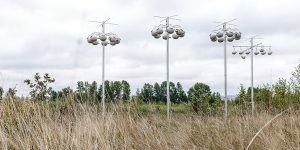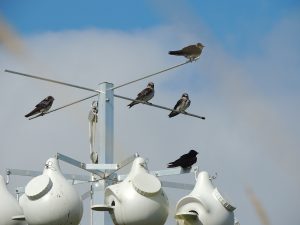Eighteen hatches and counting at Port of Vancouver USA’s Purple Martin habitat
The Port of Vancouver USA’s purple martin colony is in the midst of another successful nesting season. For the past nine years, the port has partnered with the Ridgefield National Wildlife Refuge bird experts to increase populations in Southwest Washington.

The Port of Vancouver USA’s purple martin colony
Purple martins are rare migratory birds that winter in South America and move north into the U.S. and Canada in the summer. According to the Purple Martin Conservation Association, these birds are dependent on human-supplied housing east of the Rocky Mountains. Here in the Pacific Northwest, purple martins use natural and man-made gourds and clusters of single-unit boxes for nesting, as well as natural cavities in trees. Whether utilizing a natural or man-made gourd, martin housing needs to be at least 10-feet high and located in open areas with close proximity to water – making the port’s wetland mitigation bank an ideal location.
In 2019, the port placed 32 man-made nesting gourds at the Columbia River Wetland Mitigation Bank which resulted in 20 successful hatches, an increase of 11, from 2018. The port continued with 32 gourds for the 2020 season and as of mid-August, volunteers have recorded 18 hatches. This year, volunteers also spotted five adult birds that were banded as hatchlings from other nest sites visiting the port site.
“This year’s habitat success isn’t just the number of hatches but the sightings of adult banded birds,” said port Environmental Manager Matt Graves. “Those five banded birds were from Ridgefield, Steigerwald Lake and another from Lane County, Oregon. This tells us that our habitat is meeting nesting requirements and is an encouraging sign that more purple martins will visit in the future.”

Whether utilizing a natural or man-made gourd, martin housing needs to be at least 10-feet high and located in open areas with close proximity to water
Volunteers with the wildlife refuge, under permit with the U.S. Fish and Wildlife Service, band the chicks within 12 to 21 days of hatching and document their age using a photographic scale. These fascinating birds develop day by day, to the point where their age can be identified from visual indicators such as feathering on the head or back, and wing feather emergence. Banding the birds helps the wildlife refuge and other experts with tracking the birds’ location.
The nesting season continues for another few weeks and the volunteers will continue to check the gourds periodically through September.
Environmental stewardship takes many forms and encouraging wildlife success and diversity in natural areas around the port is just one of the projects the port is conducting in its environmental efforts. Learn more about the port’s environmental efforts in its Sustainability Report.
